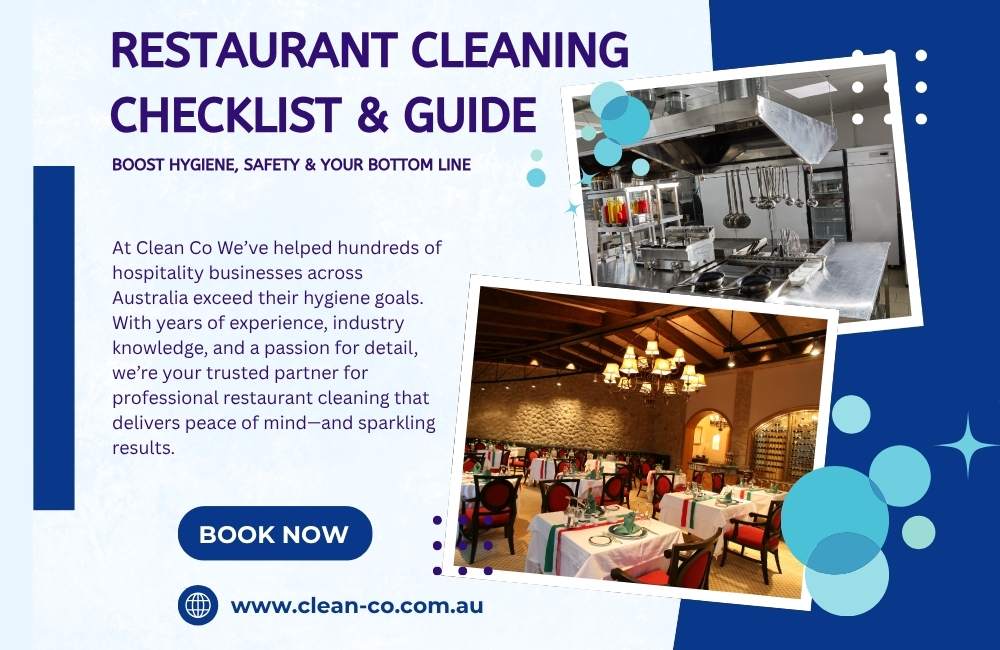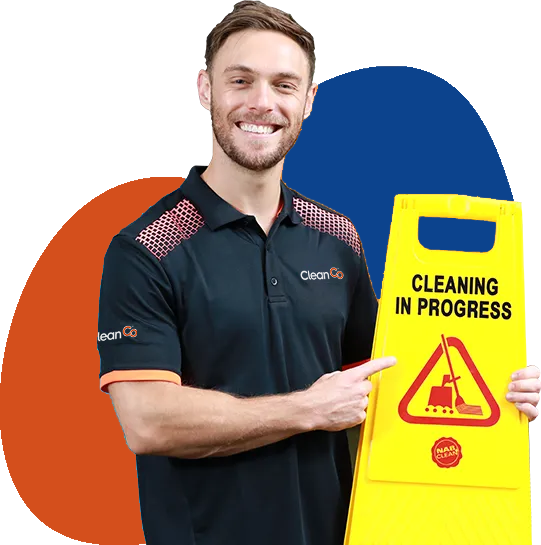Imagine walking into a restaurant with sticky tables, overflowing bins, and a musty smell hanging in the air. No matter how tempting the menu looks, chances are you won’t stay long. According to a recent survey, 75% of diners say they wouldn’t return to a restaurant with poor hygiene—even if the food was great.. In the hospitality industry, perception is reality—and cleanliness is everything.
In food service, cleanliness isn’t just about aesthetics or ticking boxes—it’s a matter of food safety compliance, customer trust, and long-term profitability From preventing food borne illness to avoiding costly fines and negative reviews, a clean restaurant forms the foundation of a successful business.
This guide is your practical road map to maintaining a safe, spotless, and legally compliant restaurant environment. Whether you run a local café, bustling bistro, or upscale eatery, you’ll find step-by-step daily, weekly, and monthly cleaning checklists designed to meet Australian standards.
Clean Co’s Role:
At Clean Co We’ve helped hundreds of hospitality businesses across Australia exceed their hygiene goals. With years of experience, industry knowledge, and a passion for detail, we’re your trusted partner for professional restaurant cleaning that delivers peace of mind—and sparkling results.
What You’ll Learn:
By the end of this guide, you’ll have:
- Actionable cleaning checklists tailored to the front and back of house
- Insights into Australian food safety laws and HACCP compliance
- Staff training tips for maintaining consistent hygiene
- Guidance on when and why to bring in professional cleaning support
Public Health & Food Safety: Protecting Your Patrons (and Your Reputation)
Even the cleanest-looking kitchen can harbour dangerous pathogens. Without strict sanitation protocols, harmful bacteria like Salmonella, E. coli, and Listeria can thrive on prep surfaces, in food storage areas, or within kitchen equipment. Cross-contamination happens quickly—and can quietly cause serious foodborne illness before anyone realises.
Preventing Outbreaks:
Implementing rigorous cleaning and sanitising routines is one of the most effective ways to prevent foodborne illness. Not only does it protect your customers, but it also safeguards your brand from PR disasters, bad reviews, and legal action.
The Customer Experience: First Impressions That Last (and Return Business)
The moment a customer steps through your door, their senses are on high alert. The shine on your floors, the sparkle of your glassware, and the smell of freshness—or the lack thereof—set the tone. Cleanliness delivers a message:We care about our space, our food, and our guests.
The “Cleanliness = Quality” Equation:
Clean surroundings are subconsciously linked to the quality of your meals and service. Customers are more likely to trust your food and return regularly if they feel your hygiene standards are high.
Data-Driven Insight:
A recent consumer study found that 86% of diners say cleanliness is the number one factor when deciding whether to return to a restaurant..
Legal Compliance & Avoiding Penalties: Staying on the Right Side of the Law
In Australia, restaurants must comply with the Food Standards Australia New Zealand (FSANZ) Food Standards Code, as well as regulations enforced by local councils and health departments These laws govern everything from safe food handling to kitchen cleanliness.
HACCP Explained:
Many Australian restaurants follow HACCP (Hazard Analysis and Critical Control Points) principles—a systematic approach to identifying and controlling food safety hazards. Cleanliness is a major part of every HACCP plan, especially for critical points like food contact surfaces, equipment, and storage areas.
Consequences of Non-Compliance:
Health inspectors have the power to issue warning notices, fines, or even shut down operations on the spot. Repeated breaches can lead to licence suspension or revocation, damaging your business permanently.
Brand Reputation & Online Reviews: Your Digital Footprint of Cleanliness
Today’s diners don’t just talk—they post. Hygiene-related reviews on platforms like Google, Yelp, and TripAdvisor can influence hundreds, if not thousands, of potential customers. One image of a dirty bathroom or insect in the dining area can go viral—and not in a good way.
Mitigating Negative Feedback:
By prioritising cleanliness and documenting your efforts, you significantly reduce the risk of poor reviews. Even better, a spotless restaurant often earns positive mentions in reviews, boosting your visibility and credibility.
Operational Efficiency & Equipment Longevity
Beyond Aesthetics:
Dirty or neglected equipment doesn’t just look bad—it works inefficiently or breaks down altogether. Regular cleaning prevents the buildup of grease, grime, and debris that can clog vents, block filters, and stress motors.
Cost Savings:
Maintaining clean equipment extends its life, reduces the need for repairs, and ensures your team can work faster and more safely. Over time, this can lead to thousands in savings on maintenance, replacements, and downtime.
Special Situations: Adapting Your Cleaning Strategy
Large functions, holidays, or peak service periods call for more than your standard cleaning routine. After a bustling night of service or a banquet, quick and thorough deep cleaning is essential to restore hygiene and readiness.
- Tailored Protocols: Adjust your cleaning schedule based on the event’s size and complexity.
- Emergency Response: Have a rapid-action plan in place for spills, broken glass, or food mishaps that can occur mid-service.
Post-Renovation Cleaning
Renovations breathe new life into a space—but they leave behind a trail of dust, debris, and construction residue.
- Post-Build Clean-Ups: Use HEPA-filter vacuums, microfibre cloths, and speciality cleaning products to remove fine dust from all surfaces, fixtures, and air vents.
- Surface Disinfection: Ensure all kitchen and service areas are re-sanitised before reopening.
Seasonal Cleaning
Each season brings unique cleaning challenges:
- Summer: Increased pest control, outdoor seating sanitation, and cooler maintenance.
- Winter: Greater focus on entryways, floor drying to avoid slips, and HVAC filter changes.
- Spring/Autumn: Ideal time for deep cleaning schedules and maintenance resets.
Empowering Your Team: Staff Training & Cleaning Roles
Cleanliness must be embedded into your restaurant’s culture.
- Training = Trust: Provide ongoing food safety and hygiene training to all team members.
- Shared Responsibility: Reinforce that every staff member—front and back of house—has a role to play in maintaining a clean and compliant space.
Implementing Systems for Success
Colour-Coded Cleaning Systems
- Minimise cross-contamination by assigning colours to areas:
- Red = Restrooms
- Blue = Food prep
- Green = Dining areas
Safe Chemical Usage
- Follow Safe Work Australia guidelines for storing, handling, and diluting cleaning chemicals.
- Display and regularly update Safety Data Sheets (SDS) in a visible location.
Cleaning Logs & Checklists
- Track task completion with signed logs.
- Use printed checklists to ensure consistency and accountability—downloadable in section 11.
Designated Cleaning Roles & Responsibilities
Define roles clearly:
- Daily huddles to review cleaning tasks.
- Assign “zone captains” for specific areas of the restaurant.
- Rotate deep-cleaning responsibilities weekly for balanced workloads.
Greening Your Clean: Eco-Friendly & Sustainable Practices
Eco-conscious cleaning is no longer optional—customers and staff expect it.
Benefits:
- Reduced chemical exposure for staff and patrons
- Better indoor air quality
- Positive brand image and environmental contribution
Sustainable Practices:
- Use GECA-certified or EcoLabel cleaning products
- Implement recycling and composting systems
- Use microfiber cloths and low-water mops to reduce waste
Clean Co’s Commitment to Sustainability
Clean Co is proud to lead the industry with:
- Certified eco-friendly cleaning agents
- Waste-conscious practices
- Partnerships with green product suppliers and industry sustainability programs
Beyond the Mop & Bucket: When to Hire Professional Cleaners
Even the most diligent in-house team can’t do it all. Some cleaning jobs require the precision, tools, and expertise of trained professionals.
Signs You Need Commercial Cleaning Support
- Persistent odours despite regular cleaning
- Recurring pest issues
- Staff overwhelmed and neglecting deeper hygiene tasks
- Buildup in grease traps, vents, and exhaust hoods
- Poor health inspection results
The Undeniable Benefits of Outsourcing to Experts
- Time Savings: Free up your team to focus on guests and food.
- Regulatory Compliance: Professionals stay updated on food safety laws.
- Advanced Equipment: From steam cleaners to high-pressure washers.
- Consistent Quality: Trained cleaners with proven processes.
- Cost-Efficiency: Avoid fines, reduce repair needs, and extend equipment life.
Why Choose Clean Co for Your Restaurant Cleaning Needs
- Industry-Specific Expertise: Specialising in restaurant cleaning and food safety compliance.
- Tailored Packages: From daily service to quarterly deep cleans.
- Flexible Scheduling: After-hours or weekend availability.
- Certified Technicians: Vetted, insured, and trained to national standards.
- Eco-Friendly Excellence: Sustainable, safe, and effective solutions.
Your Free Download: The Ultimate Restaurant Cleaning Checklist PDF
Stay compliant and consistent with Clean Co’s exclusive printable resource.
What’s Inside:
- Daily, weekly, and monthly cleaning checklists
- Colour-coded area segmentation
- Staff accountability log templates
Why You Need It:
- Ensure compliance with food safety standards.
- Streamline training and daily routines.
- Simplify documentation for audits.
Get It Now:
Download your FREE restaurant cleaning guide PDF—just sign up with your email for instant access.
Conclusion
Cleanliness isn’t just a task—it’s a business strategy.
From health and safety to brand image and customer loyalty, a structured cleaning routine is the invisible force that supports every successful restaurant.
Ready to elevate your restaurant’s hygiene standards?
Partner with Clean Co.—Australia’s trusted name in professional restaurant cleaning.


